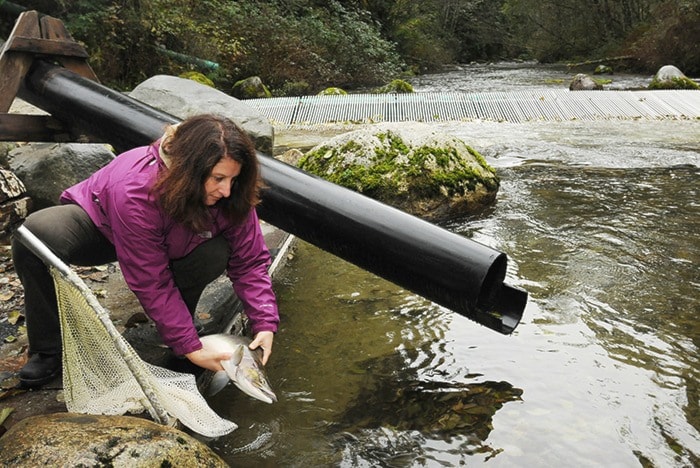Sockeye salmon that return to the South Alouette River and Alouette Lake are not spawning and the Alouette River Management Society wants to find out why.
It’s proposing to trap 10 of the sockeye-kokanee this year, breeding fry from them, then releasing them next spring.
Sockeye-kokanee fry, formerly considered landlocked kokanee and nicknamed “sockanee,” have been released over the dam’s spillway each year since 2005 in hope the adults would return from the ocean in a few years to spawn.
The goal is to re-establish a sockeye run in the South Alouette River that was wiped out in 1926, when B.C. Hydro built the dam, sealing the sockeye in the lake and cutting off those in the river from their spawning grounds.
A $40,260 grant from B.C. Hydro’s Fish and Wildlife Compensation Program will pay for the study, which will try to determine if the sockanee that have been in the ocean and return to spawn are more likely to produce offspring, which will also migrate to the ocean, making it easier to re-establish the sockeye, or sockanee, run.
Currently, the sockeye, usually about 100 or so, that return to spawn are trapped at the base of the dam, then carried by truck across the dam and released into the lake.
According to a report to council, the reasons the sockeye are not spawning could be the stressful process of trapping and trucking the fish, lack of suitable spawning conditions in the lake, disease or parasites.
Another $66,715 will fund the B.C. Conservation Foundation for the fourth of a five-year study to prioritize locations for restoring fish habitat to help species at risk.
The Alouette River Management Society also wants to move the location where it raises sockeye fry to the upper hatchery near the women’s prison.
The society says the upper hatchery, fed by Allco Springs, could be more suitable, than the lower hatchery near the Rivers Heritage Centre.
As result, the society has asked the District of Maple Ridge to reallocate the $30,000 they had sought for a new well at the lower hatchery to the upper hatchery.
The society is currently making a business case to build a $4-million fishway connecting the river to the lake. That would allow several species of salmon and trout to access the spawning grounds upstream.
Fish habitat is also getting more immediate help thanks to other grants from the Fish and Wildlife Compensation Program.
One project, excavating mud from a sediment pond in Mud Creek and replacing a small wooden dam at the base of the pond, will also make life easier for trout and salmon.
The Alouette River Management Society is getting $29,882 from the program for the project.
Meanwhile, the Ministry of Forest, Lands and Natural Resource Operations gets $27,416 to study bull trout population in the Alouette Lake reservoir. It’s the first step towards restoring the fish back to the reservoir, behind the Alouette dam.
The long-term goal is to build a sustainable bull trout population in the lake, building another species for sports fishing.
